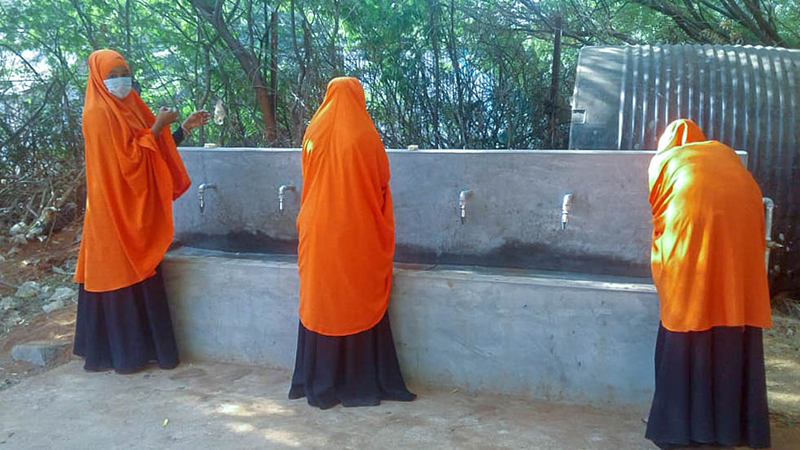CDC Works to Improve Hand Hygiene in Refugee Camps Now and in the Future

Three boys using a handwashing station constructed at the Wadarji Primary School in the Dagahaley camp in the Dadaab refugee camp.
Photo by Peter Mndanyi/CARE Kenya
Washing hands with soap and clean water is one of the most effective ways to reduce the spread of disease. Proper hand hygiene was a key recommendation early in the COVID-19 pandemic when masks were not always available and vaccines had not been developed. Today, it remains a vital precaution, especially when people live in crowded conditions, such as in a refugee camp.
CDC has worked in the Dadaab refugee camp in Eastern Kenya for more than two decades and recognized that people needed better access to clean water and soap to be able to wash their hands regularly. In 2020, the agency partnered with CARE International to improve access to these resources.
Home to More Than 200,000 Refugees
Dadaab was first to set up in 1991 to provide a temporary safe haven for 90,000 Somali refugees fleeing the civil war in their country. Thirty years later, this refugee camp still exists, except it’s grown into three camps on the Dadaab location. The United Nations High Commissioner for Refugees (UNHCR), which manages the camp, says 218,873 registered refugees 1 and asylum seekers were living in Dadaab at the end of July 2020, down from a peak of close to half a million refugees in 2011 when it was the largest refugee camp in the world. The Dadaab camps are now made up of naturally grown towns and have developed into commercial hubs connecting Northeastern Kenya and Southern Somalia.

Three female students at the Halane Primary School wash their hands at a new handwashing station supported by CDC and CARE International.
Photo by Peter Mndanyi/CARE Kenya
“We started conversations with our partner CARE International in April 2020 because we wanted to promote the importance of handwashing and how it can help protect people from COVID-19 and ensure there was enough infrastructure established in community settings and in healthcare facilities for handwashing,” says Anangu Rajasingham, an engineer in CDC’s Global Water, Sanitation and Hygiene (WASH) program.
Rajasingham and her colleagues in the WASH program in the Emergency Response and Recovery Branch work in humanitarian crisis locations to help improve access to water, sanitation, and hygiene services in a variety of settings, from refugee camps to cities, after natural disasters, conflicts, and outbreaks.
Handwashing Stations and Prevention Messages
Keeping hands clean has remained one of the key recommendations to prevent COVID-19 from spreading. The goal of this CDC and CARE project in Dadaab is to help refugees living in the camps have better access to safe and appropriate water, sanitation, and hygiene facilities and learn how to prevent the spread of COVID-19.
CARE has been on the ground working in Dadaab since 1992. So, partnering with them on this project came easy. In this camp, CARE is UNHCR’s lead agency for water and sanitation.
Since CDC staff couldn’t travel last year because of the pandemic, they worked remotely with the CARE team on the ground. Funding from the U.S. government’s Coronavirus Aid, Relief, and Economic Security (CARES) Act helped CDC pay for handwashing stations and education materials to stop COVID-19.
“Funding began to arrive in Kenya in late August and September,” Rajasingham explains, adding that the construction of the handwashing stations began by the end of the year.
“To date, 30 handwashing stations were built at schools, 5 in healthcare facilities, and 60 have been installed in strategic community settings like public markets,” says Rajasingham. They’ve been designed to minimize crowding and touching surfaces.
The handwashing stations at the schools have been designed to be the right size for children.

Two girls and one boy wash their hands at a washing station, built with support from CDC and CARE at the Central Primary School in the Dagahaley camp.
Photo by Peter Mndanyi/CARE Kenya
Spreading Hygiene Behaviors, Not Germs
Placing these stations in schools serves another important purpose. CDC and CARE are seizing the opportunity to teach children about hand hygiene during the COVID-19 pandemic while also preparing them for future outbreaks, says Tom Handzel, PhD, an epidemiologist (often referred to as a “disease detective”) who leads CDC’s Global WASH team.
“What we want to do is take advantage of the attention on COVID-19, and use hand hygiene to protect people,” says Handzel, “but we also want to get the message about hygiene across in general.”
Children who learn about the importance of frequent handwashing can spread this healthy behavior to family members and others throughout their life.
Rajasingham notes that infrastructure such as the handwashing stations is essential, but so are hygiene promotion activities. Two hygiene educators were hired for each school to share information on hygiene, and others are sharing messages in food distribution lines. These investments will pay off not only during the COVID-19 pandemic but for years to come.
“Behavior change isn’t easy,” Handzel explains. “But in a crisis, people will adopt behavior change more quickly.”